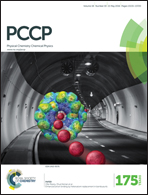Gas phase complexes of H3N⋯CuF and H3N⋯CuI studied by rotational spectroscopy and ab initio calculations: the effect of X (X = F, Cl, Br, I) in OC⋯CuX and H3N⋯CuX†
Abstract
Complexes of H3N⋯CuF and H3N⋯CuI have been synthesised in the gas phase and characterized by microwave spectroscopy. The rotational spectra of 4 isotopologues of H3N⋯CuF and 5 isotopologues of H3N⋯CuI have been measured in the 6.5–18.5 GHz frequency range using a chirped-pulse Fourier transform microwave spectrometer. Each complex is generated from a gas sample containing NH3 and a halogen-containing precursor diluted in Ar. Copper is introduced by laser ablation of a solid target prior to supersonic expansion of the sample into the vacuum chamber of the microwave spectrometer. The spectrum of each complex is characteristic of a symmetric rotor and a C3v geometry in which the N, Cu and X atoms (where X is F or I) lie on the Ca3 axis. The rotational constant (B0), centrifugal distortion constants (DJ and DJK), nuclear spin-rotation (Cbb(Cu) = Ccc(Cu)) constant (for H3N⋯CuF only) and nuclear quadrupole coupling constants (χaa(X) where (X = N, Cu, I)) are fitted to the observed transition frequencies. Structural parameters are determined from the measured rotational constants and also calculated ab initio at the CCSD(T)(F12*)/AVQZ level of theory. Force constants describing the interaction between ammonia and each metal halide are determined from DJ for each complex. Trends in the interaction strengths and geometries of B⋯CuX (B = NH3, CO) (X = F, Cl, Br, I) are discussed.


 Please wait while we load your content...
Please wait while we load your content...